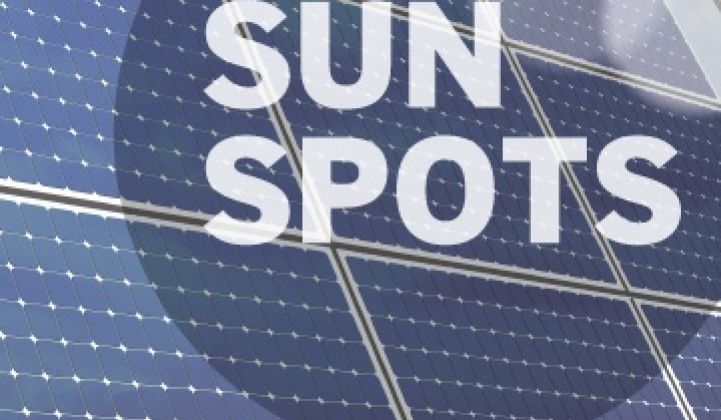The blowback from state investment in solar startups is going to be painful -- more so for workers than for politicians.
My original intention was to write a brief article on SoloPower, a CIGS (copper indium gallium diselenide) thin-film solar startup that just won some cash from Oregon to establish a beachhead factory there. SoloPower is looking to commercialize CIGS solar on flexible substrates for flat and low-slope commercial and industrial rooftops. The firm uses an electroplating-like technology to deposit the CIGS layer cake.
That would have been one of many articles we've written on U.S. states bending over backwards to attract solar startups. Politicians are eager to win jobs for their constituency and to get a piece of that hot greentech action.
States are offering tax breaks on real estate and capital outlays, training for the workforce and whatever it takes to get CEOs and boards to relocate their long-shot startups to solar hot beds like Hopewell Junction, NY and Senatobia, Mississippi.
Here's a partial list of state giveaways to early-stage solar firms:
Government Incentives For Solar Firms
|
Firm |
State |
Value |
Details |
|
AQT (CIGS) |
SC |
massive incentive program |
Job training, tax breaks |
|
Evergreen (c-Si) |
MA |
up to $58M |
Shutting down factory and laying off 800. |
|
HelioVolt (CIGS) |
TX |
$1M |
$1M from the Texas Enterprise Fund calling for the creation of 158 jobs. The agreement was altered because the requisite jobs were not created. |
|
Solexant (CdTe) |
OR |
$25M |
$25M loan |
|
Solopower (CIGS) |
OR |
$40M |
Loans and tax credits |
|
NY |
$8M in tax credits |
Shutting down factory and laying off more than 100 |
|
|
Stion (CIGS) |
MS |
$75M |
Over the next 5 years, Stion says it expects to invest $500M and create 1,000 jobs in the state. |
|
Abound (CdTe) |
IN |
$25M |
Tax credits, training grants |
|
Twin Creeks (c-Si) |
MS |
NA |
Secretive ion implant technology |
Although many of these firms were founded in California, California seems unwilling to offer as much as many other states to keep manufacturing here. The state has offered a large amount of tax breaks to firms such as Solyndra, Nuvosun, Solaria and First Solar's CIGS effort, but has lost AQT, Stion, Twin Creeks, SoloPower and Solexant. (More details are available in this PDF: http://treasurer.ca.gov/caeatfa/staff/20101117/4b.pdf.)
Left off the above table was W Solar's move to Wisconsin, as well as Arizona luring a small Suntech factory to their state, both Asian c-Si firms. W received $28 million in enterprise zone tax credits.
Still, the recent examples of Spectrawatt and Evergreen closing incentivized factories rings loud and clear -- manufacturing solar panels or cells, especially c-Si, in the U.S. is going to be an enormous challenge.
Greentech Media Research Solar Analyst MJ Shiao suggests, "The question is really where public subsidies are best suited: scale manufacturing, R&D/innovation, or demand-side. There's certainly a place for all three, but it's difficult to look at the data from the post-2009 solar manufacturing era and think that the U.S. can compete at the gigawatt production scale with [China's] cheap land, cheap labor, low cost loans, and lax environmental and labor policies. Our subsidies seem best served on our strengths of demand-side and R&D innovation (thin film, CSP, residential leases, PPAs, etc.)."
Most venture capital-funded solar firms are going to fail. That's not cynical; that's just realistic VC math.
For states to bet the farm on these one-in-ten shots to succeed is less than intelligent fiscal policy. I can only imagine the due diligence performed by these state-level decision makers:
"We've heard solar is the technology of the future. We've heard thin-film solar uses less material and is cheaper. Why, look at the success of First Solar! And the consultant we hired to tell us what we want to hear has told us just that. Here's $50 million in tax credits. Please build your factory here. We'll help provide roads, electrical hookups, and job training."
Two or three years later, nine out of ten of these firms are going go belly-up, leaving thousands of workers unemployed and the politicians likely unscathed.
As MJ Shiao claimed and as we've reported, the value for the U.S. in solar is not going to be in panel manufacturing but in the demand-side build and services like constructing solar farms and installing residential photovoltaics.
One or two of these firms will succeed. Hopefully.
But in most cases, subsidizing doomed solar manufacturing is not going to work out very well -- and we will watch that unfold over the next few years.



